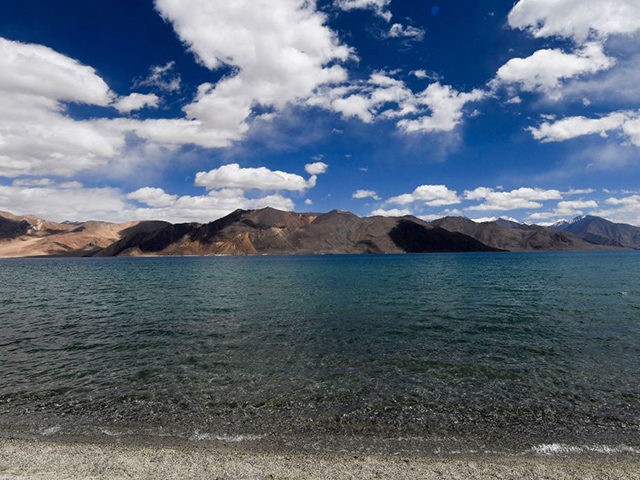India increased its military presence along at least one part of its border with China, Reuters reported Wednesday, anticipating a response from the communist nation for India’s removal of People’s Liberation Army (PLA) troops allegedly attempting to establish an illegal presence in India this weekend.
Indian authorities revealed Monday that Indian soldiers had identified a contingent of as many as 200 PLA forces moving to seize a mountaintop near Pangong Tso, a lake that straddles India’s Ladakh region and Chinese-occupied Tibet. The Indian troops confronted and removed the Chinese soldiers, establishing a presence on the mountaintop looking into China, according to New Delhi. Some reports have indicated that a Tibetan soldier on the Indian side died in the confrontation, but most reports initially claimed no casualties.
“On the night of August 29/30, PLA troops violated the previous consensus arrived at during military and diplomatic engagements over the ongoing standoff in Eastern Ladakh and carried out provocative military movements to change the status quo,” Col. Aman Anand, a spokesman for the Indian Army, reportedly said.
Chinese Communist Party officials have loudly protested India establishing a new base in disputed territory, accusing the Indian government of attempting to colonize Chinese land.
This weekend’s incident followed a deadly brawl in June, the most violent exchange between the two nations since the 1940s, triggered by Indian soldiers questioning PLA troops that had built an illegal military encampment in India’s Galwan Valley. Indian officials claimed the exchange this weekend was an attempt to prevent the Chinese from establishing a similar encampment.
Reuters reported Wednesday that the number of Indian troops in Anjaw, Arunachal Pradesh, had significantly increased in recent weeks. Arunachal Pradesh borders China to its east and Ladakh to its north. Reuters notes that the Chinese Communist Party refers to Arunachal Pradesh as “South Tibet.”
“India has moved troops to its eastern stretch of border with China since clashes erupted between the nuclear-armed rivals on the western part of their border in the Himalayas in June, a government official said,” according to the news agency.
“There has been an increase in troop deployment since the Galwan incident, and even prior to that we’d started,” an Anjaw official Reuters identified as Ayushi Sudan told the agency. “The military presence has surely increased, but as far as incursions are concerned, there are no verified reports as such.”
An Arunanchal Pradesh lawmaker told Reuters, however, that Chinese soldiers regularly violated India’s sovereignty in the area.
“It’s a regular phenomenon, it’s nothing new,” Tapir Gao lamented.
India’s Zee News, whose reports typically favor Prime Minister Narendra Modi, reported Wednesday that Indian troops are on “high alert” for further Chinese military action, citing unnamed Union Ministry of Home Affairs sources, and that military forces are conducting increased patrols on the border.
“According to the sources, instructions were issued after the crucial meeting to increase vigilance on India’s borders with China, Nepal, Bhutan. The Indian security forces have been asked not to move from the heights as they are within the country’s perception of the Line of Actual Control (LAC),” Zee News claimed.
Similarly, the Times of India reported that the situation in Ladakh, the border area where the Galwan Valley clash occurred, “is on a knife’s edge.” The newspaper asserted that PLA troops had attempted to cement their presence on Indian territory even after failing to do so this weekend.
The Times of India claimed Chinese soldiers made a failed attempt Monday to remove Indian troops from the Pangong Tso peak.
“On Monday, PLA troops tried to climb up the heights and come closer to our positions at a few locations on the southern bank of Pangong Tso and Spanggur Gap. They apparently wanted to dislodge our soldiers but were suitably cautioned and outmaneuvered. The warning was conveyed at the flag meeting also,” an unnamed “senior officer” told the newspaper.
“The Chinese army brass is furious at the way PLA has been checkmated by the Indian Army’s pro-active military maneuver to occupy multiple heights near the southern bank of Pangong Tso, Rezang La, Reqin La, and Spanggur Gap on August 29-30,” the newspaper claimed. It noted that the incident on Monday had no recent precedent, as the Indian military confronted Chinese troops first, rather than waiting for them to cross the border.
“This is, in fact, the first time that India has acted in such a ‘tit for tat’ manner since the military confrontation began four months ago,” the Times of India said, citing the unnamed officer.
The Chinese Foreign Ministry has seized on India’s description of the events as pre-emptive to accuse New Delhi of unwarranted aggression.
“The Indian side claims it ‘pre-empted’ some activities. … India’s statements reveal the fact that the Indian troops were the first to have illegally crossed the LAC [India-Chinese border], made provocations, changed the status quo in the border areas, and violated bilateral agreements and important consensus,” Chinese Foreign Ministry spokeswoman Hua Chunying told reporters on Wednesday. Hua praised her government for “maximum restraint” exhibited in the face of an unruly India.
“We urge India to strictly discipline its border troops, stop all provocations at once, immediately withdraw all personnel who illegally trespassed across the LAC, and stop taking any actions that may escalate tensions or complicate matters,” Hua said.

COMMENTS
Please let us know if you're having issues with commenting.